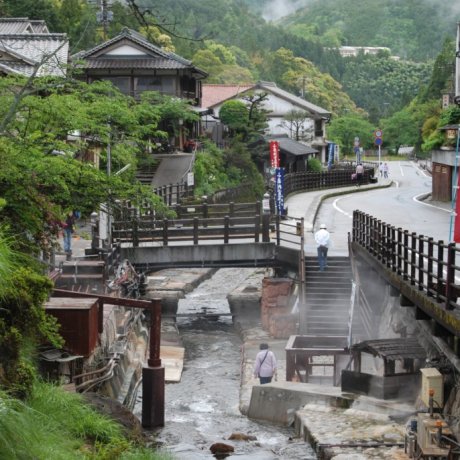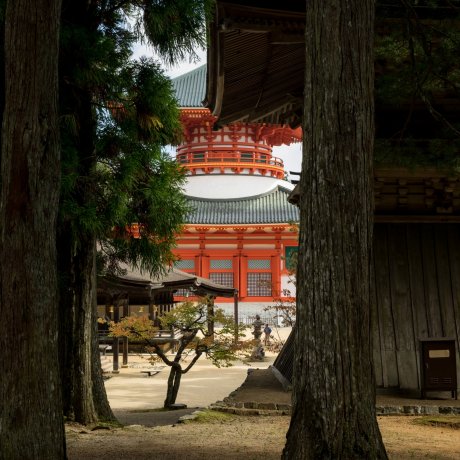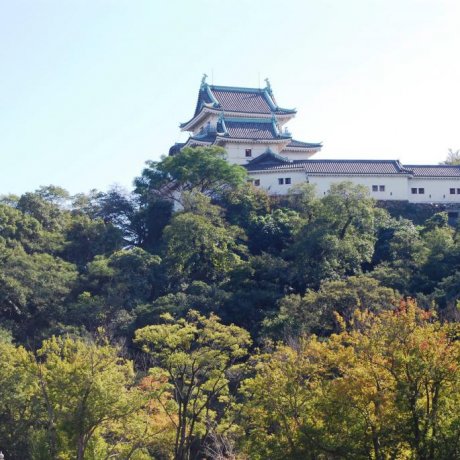Wakayama Prefecture is a historical wonder and the spiritual heartland of Japan. Located on the Kii Peninsula in the Kansai area of Japan, Wakayama is home to the famous Kumano Kodo pilgrimage route, the holy mountain Koyasan, and much more.
Video: Koyasan & Kumano
We have gathered ten of our favorite locations across the area.
In addition, traveling in Wakayama has never been easier thanks to the revamped bus routes recommended by Wakayama Prefecture every hiking season from September to November. For those not up for the full pilgrimage on foot, it is now possible to see many of the top tourist destinations using the all-new unlimited-ride bus pass. More.
One of the most fascinating aspects about Wakayama is the trekking experience along the spiritual Kumano Kodo path which has been considered a sacred area since prehistoric times and most of the items on our list below can be found along the path. Here are the top 10 things to do in Wakayama, in no particular order:
1. Koyasan
Koyasan is the common name of a huge temple settlement and monastery complex located in the lush forestlands of Wakayama. The pilgrimage routes through the sacred sites of the Kii Mountain Range make Koyasan part of a designated UNESCO World Heritage Site. Founded by the monk Kobo Daishi in the year 816 AD, Koyasan has flourished for over 1,200 years as an active monastic center. There are over 100 buildings in the area, including more than 50 temples, which offer temple lodging for a truly unique and spiritual stay filled with tranquility and experiences such as meditation, sutras, and authentic Buddhist cuisine known as Shojin-ryori.

Rengejo-in is one such temple lodging, located in the center of Koyasan. In addition to the previously mentioned experiences, this traditional lodging offers religious services with Buddhist priest chants and an on-site fire ceremony experience for guests.

Koyasan Reihokan is an art museum on Koyasan that displays ancient Buddhist art. The collection is centered around articles from the Heian and Kamakura periods and includes paintings, calligraphy, sutras, sculpture, and Buddhist ritual objects. Konpon Daito is a massive 48.5-meter tower painted in vermilion that has become a symbol of Koyasan.

There are a few other spots on our top ten from Koyasan, listed separately below.
2. Nachi Waterfall / Daimon-zaka
Nachi Waterfall is one of the best-known waterfalls in Japan. At 133 meters, it is the highest waterfall cascade in Japan and is revered as the embodiment of Shinto deity, Hirou Gongen.

Kumano Nachi Taisha is a Shinto shrine and, with the neighboring Nachisan Seiganto-ji Tendai Buddhist Temple, is part of the UNESCO-designated World Heritage Sacred Sites and Pilgrimage Routes in the Kii Mountain Range of Japan. The shrine and temple are located side-by-side within a short distance of the massive waterfall and serve as an example of the harmonious mix of Shintoism and Buddhism across Japan.

A three-story vermilion pagoda makes up part of the Nachisan Seiganto-ji complex and with the falls located directly behind, it creates one of the most iconic and spiritual vistas in all of Japan.
The nearby Daimon-zaka is one of the most famous and photogenic paths of the Kumano Kodo pilgrimage route. This cobblestone staircase runs about 600 meters long and is lined with centuries-old Japanese cedar trees, camphor trees, and bamboo groves. In the Daimon-zaka Chaya travelers can rent Heian period kimonos before setting out on the path. Once you get to the top, you can catch the first glimpse of the iconic Nachi Waterfall.
Fairly close to Nachi, at the southern tip of Wakayama, visitors may also want to head to Kushimoto and the Hashiguiiwa rock formations. These coastal rocks are famous for the interesting shapes and dynamic sounds as the waves crash into them.

- Nachisan, Nachikatsuura, Higashimuro District, Wakayama 649-5301
- 8:30 - 16:30 (Closed now)
3. Kumano Hongu Taisha Grand Shrine
In case you have not noticed the theme, each of the first three locations has been along the Kumano Kodo ancient pilgrimage route. These sacred trails were—and still are—used for the pilgrimage to the sacred site “Kumano Sanzan” or the three Grand Shrines of Kumano: Kumano Hongu Taisha, Kumano Nachi Taisha, and Kumano Hayatama Taisha.

Kumano Hongu Taisha is a Shinto shrine located in Tanabe, deep in the mountains. With beautiful roofs and cypress paneling, this shrine as part of the Kumano Sanzan serves a central part of the Kumano faith which boasts over 3,000 shrines around Japan. The original shrine was once located at Oyunohara and moved to its current location due to an unstable sandbank during the great floods in the 19th century.

Oyunohara Gate could easily have its own spot on this list, but we have bundled two in one; standing at the entranceway to the previous location of Kumano Hongu Taisha, this massive shrine measures nearly 34 meters tall and 42 meters wide making this the world's largest torii shrine gate. The gate marks the entrance to a truly sacred area.
4. Shirarahama Beach / Engetsuto (Engetsu Island)
With more than 600 kilometers of coastline, Wakayama is lined with numerous beaches, including white sandy beaches. One such seaside locale known for its expansive white-sand beach and laid-back atmosphere is Shirarahama Beach. This white-sand resort is over 600 meters long and is the sister beach to Hawaii's Waikiki Beach. The area is famous for sand and sun, but also a popular surfing area. Kumanosansho-jinja Shrine stands along the beach, giving this a distinctly Japanese feel. July and August are the peak times for swimming season.

Engetsuto Island is the nickname for a small island off the coast of Shirahama, properly called Taka Island. Its nature-made arch lets seawater pass through; the hole was formed through the combined effects of wind, waves, and time. The nickname Engetsu means “full moon” and it’s easy to see why the name has stuck thanks to this formation. The island measures just 130 meters from north to south. Glass bottom boat tours are offered around the island and its clear waters make it easy for visitors to see tropical fish and corals.

5. Kumano Hayatama Taisha Grand Shrine
The last of the three Grand Shrines of Kumano may be the most visually striking, it's definitely the most vibrant and colorful of the group. The shrine buildings are lacquered in a stunning white and orange vermilion color. There is a legend that this shrine was built as a place to worship the first gods who descended to earth on the nearby Gotobiki-iwa Rock, which is noted below as a separate location.

The Kumano Shimpokan, Sacred Treasure Hall, houses more national treasures than most major museums and has some 1,200 treasures in total—many of which were donated to the shrine by nobility and royalty during pilgrimages. In addition, these grounds hold a sacred conifer tree which is a national monument of its own and the largest of its type in Japan.

6. Kongobu-ji Head Temple and Banryutei Rock Garden (Koyasan)
The second of our three Koyasan-related spots, Kongobu-ji Temple, is the head temple of Koyasan Shingon Buddhism. The name means Temple of the Diamond Mountain Peak. One of the most prominent sites at Koyasan, the temple grounds and interior can be explored inside and out. Local monks are often found training, as the area acts as a focal point in their studies.

The Banryutei, in the rear of the temple, is Japan's largest rock garden and is a must-see spot. In the center of the rock garden is an exclusive lodging reserved for the family of the Emperor of Japan.
7. Okuno-in (Koyasan)
The last of the Koyasan locations on this list, Okuno-in is considered the holiest grounds in Koyasan—and one of the holiest locations in all of Japan. The two-kilometer path along the cemetery contains more than 500,000 tombstones and monuments, including many feudal lords and prominent figures who chose to rest in proximity to the venerable Kobo Daishi.

The paths are lined with trees, many are several hundred years old. There are a few bridges along the path, including the Gobyobashi Bridge, which separates the innermost grounds. At the end of the path, visitors will find the Kobo Daishi mausoleum where the honored monk is said to still be carrying out his endless pursuit of knowledge.

Night tours offer a surreal experience to view the area, but not all paths are well lit and the mausoleum buildings are closed.
8. Yunomine Onsen
This ancient town along the pilgrimage route is known for its hot springs and historic Japanese-style inns. Located deep in the Kumano Mountains in a small valley, the waters here are said to change colors seven times over the course of the day. Known to be one of the oldest hot spring locations in Japan, the waters are believed to have been discovered around 1,800 years ago.

The waters here are now an essential part of the Kumano pilgrimage tradition. Purification rituals completed here, near the end of the long journey, are in preparation for worship at the nearby Kumano Hongu Taisha. The village centers around the spring that runs through the town like a river. Many travelers use the public hot springs as a cooking basin for eggs, which can be purchased nearby in small batches and cooked to a partially boiled state known as onsen tamago in minutes.

Tsuboyu is a small cabin near the creek where visitors can privately bathe for up to 30 minutes. This is one of the only hot springs in the world that is both available for public bathing and a UNESCO World Heritage Site. The location is known in kabuki tales for its ability to heal certain incurable diseases. Private use is available for one to two people at a time on a first-come-first-served basis and it is quite popular for couples.


The Healing Powers of Yunomine Onsen
Yunomine is a small hot spring village in Wakayama Prefecture, Japan. Legend has it that water from a statue of Yakushi Nyorai was..
9. Kamikura-jinja Shrine / Gotobiki-iwa Rock
The location of this small shrine was selected for its sacred location believed to be the descending point of many Shinto gods. The massive boulder here crowns a cliff that rises steeply from the ground and overlooks Shingu City. Kamikura-jinja Shrine is described as one of the oldest destinations along the Kumano Kodo pilgrimage route and even predates the Three Grand Shrines.

More than a shrine, the path leading up to the boulder is itself an incredible journey up over 500 irregular-shaped, steep stone steps. The pathway is not easy, nor for the faint of heart, but the climb is well worth the effort. Those who succeed are rewarded with the sight of a true Shinto shrine blended with nature, not to mention some amazing views of the surrounding area from up high.

10. Wakayama City / Wakayama Castle
While not a single attraction, Wakayama City is the gateway to the area and a day exploring the city is an excellent way to start any Wakayama adventure.
Wakayama Castle overlooks the city and still has an original moat and stone wall. It is one of Japan's finest castles and particularly impressive in spring when the cherry trees are in full bloom. The nearby Momijidani Japanese Garden, especially beautiful in autumn colors, includes a teahouse where visitors may sample matcha green tea.
The castle museum located inside the main castle building is open to the public and houses historic artifacts. Views from the keep offer excellent vistas of the city and bay area.

The Kuroshio area is a vibrant market filled with some of the region's best seafood options and plenty of souvenirs that represent Wakayama culture. Try fresh seafood in the outdoor barbecue areas for lunch and have a relaxing soak at the Kishu Kuroshio Onsen.
For a Japanese take on Europe, the nearby Porto Europa is a theme park designed to resemble Mediterranean harbor towns. It is a fun option for children and families looking for some extravagant food and amusement based on medieval European townscapes.
Discover Wakayama by Bus
As seen on the official prefecture website, until November 30th, 2019, the Koyasan and Kumano Access Bus connects multiple world heritage sites on a sacred ride through central Wakayama. Four daily departures along this route run between Koyasan Station and Hongu Taisha-mae.

The Kumano Kotsu Bus pass offers three days of unlimited bus rides between all locations on the map below. This pass is available for those who have purchased a pass for the Koyasan and Kumano Access Bus.

All bus passes may be purchased at the following locations:
- Koyasan Nankai Rinkai Bus Office [Google Map]
- Kumano Kotsu Kii-Katsuura Station Ticket Office [Google Map]
- Kumano Kotsu Shingu Station Ticket Office [Google Map]


































